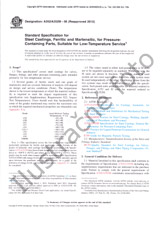Potrebujeme váš súhlas na využitie jednotlivých dát, aby sa vám okrem iného mohli ukazovať informácie týkajúce sa vašich záujmov. Súhlas udelíte kliknutím na tlačidlo „OK“.
ASTM E1402-13(2018)
Standard Guide for Sampling Design
NORMA vydaná dňa 1.11.2018
Informácie o norme:
Označenie normy: ASTM E1402-13(2018)
Poznámka: NEPLATNÁ
Dátum vydania normy: 1.11.2018
Kód tovaru: NS-904628
Počet strán: 8
Približná hmotnosť: 24 g (0.05 libier)
Krajina: Americká technická norma
Kategória: Technické normy ASTM
Kategórie - podobné normy:
Zkušebnictví (názvosloví)
Zkušební podmínky a postupy všeobecně
Anotácia textu normy ASTM E1402-13(2018) :
Keywords:
area sample, bulk sample, cluster sample, finite population, probability proportional to size, quota sample, sample size, sampling frame, sampling without replacement, simple random sample, stratified sample,, ICS Number Code 01.040.19 (Testing (Vocabularies)),19.020 (Test conditions and procedures in general)
Doplňujúce informácie
| Significance and Use | ||||||||||
|
4.1 This guide describes the principal types of sampling designs and provides formulas for estimating population means and standard errors of the estimates. Practice E105 provides principles for designing probability sampling plans in relation to the objectives of study, costs, and practical constraints. Practice E122 aids in specifying the required sample size. Practice E141 describes conditions to ensure validity of the results of sampling. Further description of the designs and formulas in this guide, and beyond it, can be found in textbooks (1-10).3 4.2 Sampling, both discrete and bulk, is a clerical and physical operation. It generally involves training enumerators and technicians to use maps, directories and stop watches so as to locate designated sampling units. Once a sampling unit is located at its address, discrete sampling and area sampling enumeration proceeds to a measurement. For bulk sampling, material is extracted into a composite. 4.3 A sampling plan consists of instructions telling how to list addresses and how to select the addresses to be measured or extracted. A frame is a listing of addresses each of which is indexed by a single integer or by an n-tuple (several integer) number. The sampled population consists of all addresses in the frame that can actually be selected and measured. It is sometimes different from a targeted population that the user would have preferred to be covered. 4.4 A selection scheme designates which indexes constitute the sample. If certified random numbers completely control the selection scheme the sample is called a probability sample. Certified random numbers are those generated either from a table (for example, Ref (11)) that has been tested for equal digit frequencies and for serial independence, from a computer program that was checked to have a long cycle length, or from a random physical method such as tossing of a coin or a casino-quality spinner. 4.5 The objective of sampling is often to estimate the mean of the population for some variable of interest by the corresponding sample mean. By adopting probability sampling, selection bias can be essentially eliminated, so the primary goal of sample design in discrete sampling becomes reducing sampling variance. |
||||||||||
| 1. Scope | ||||||||||
|
1.1 This guide defines terms and introduces basic methods for probability sampling of discrete populations, areas, and bulk materials. It provides an overview of common probability sampling methods employed by users of ASTM standards. 1.2 Sampling may be done for the purpose of estimation, of comparison between parts of a sampled population, or for acceptance of lots. Sampling is also used for the purpose of auditing information obtained from complete enumeration of the population. 1.3 No system of units is specified in this standard. 1.4 This standard does not purport to address all of the safety concerns, if any, associated with its use. It is the responsibility of the user of this standard to establish appropriate safety, health, and environmental practices and determine the applicability of regulatory limitations prior to use. 1.5 This international standard was developed in accordance with internationally recognized principles on standardization established in the Decision on Principles for the Development of International Standards, Guides and Recommendations issued by the World Trade Organization Technical Barriers to Trade (TBT) Committee. |
||||||||||
| 2. Referenced Documents | ||||||||||
|
Odporúčame:
Aktualizácia zákonov
Chcete mať istotu o platnosti využívaných predpisov?
Ponúkame Vám riešenie, aby ste mohli používať stále platné (aktuálne) legislatívne predpisy
Chcete vedieť viac informácií ? Pozrite sa na túto stránku.




 Cookies
Cookies
